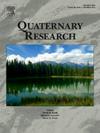南美洲西北部加勒比海和太平洋沿岸全新世相对海平面的变化
IF 1.8
3区 地球科学
Q3 GEOGRAPHY, PHYSICAL
引用次数: 0
摘要
预测沿岸的变化取决于我们对冰期后相对海平面变化的了解,而冰期后相对海平面的变化 部分受冰盖融化的冰-等静止反应的控制。在这里,我们通过对两种地幔粘度方案(全球标准平均粘度和高粘度)的海平面方程进行数值求解,重建了南美洲西北部加勒比海和太平洋沿岸冰川期后的相对海平面变化。我们使用标准模型(适用于太平洋沿岸)得出的结果与先前的研究一致,表明北格里皮斯中期高位约为 2 米。高粘度模拟(适用于加勒比海沿岸)表明,劳伦泰德冰盖的远场影响向中场影响的过渡发生在曼萨尼约德尔马和莫罗斯基约湾之间。在此位置以南,哥伦比亚加勒比海沿岸呈现出静止状态,全新世相对海平面几乎保持不变。通过分析我们的模拟结果,考虑到海平面指标,我们认为构造作用比之前假设的更为突出,尤其是在加勒比海沿岸。这种影响阻碍了对南美洲西北部沿海地区相对海平面变化的简单看法。本文章由计算机程序翻译,如有差异,请以英文原文为准。
Holocene relative sea-level changes along the Caribbean and Pacific coasts of northwestern South America
Predicting coastal change depends upon our knowledge of postglacial relative sea-level variability, partly controlled by glacio-isostatic responses to ice-sheet melting. Here, we reconstruct the postglacial relative sea-level changes along the Caribbean and Pacific coasts of northwestern South America by numerically solving the sea-level equation with two scenarios of mantle viscosity: global standard average and high viscosity. Our results with the standard model (applicable to the Pacific coast) agree with earlier studies by indicating a mid-Northgrippian high stand of ~2 m. The high-viscosity simulation (relevant to the Caribbean coast) shows that the transition from far- to intermediate-field influence of the Laurentide Ice Sheet occurs between Manzanillo del Mar and the Gulf of Morrosquillo. South of this location, the Colombian Caribbean coast has exhibited a still stand with a nearly constant Holocene relative sea level. By analyzing our simulations considering sea-level indicators, we argue that tectonics is more prominent than previously assumed, especially along the Caribbean coast. This influence prevents a simplified view of regional relative sea-level changes on the northwestern South American coast.
求助全文
通过发布文献求助,成功后即可免费获取论文全文。
去求助
来源期刊

Quaternary Research
地学-地球科学综合
CiteScore
4.70
自引率
8.70%
发文量
57
审稿时长
3 months
期刊介绍:
Quaternary Research is an international journal devoted to the advancement of the interdisciplinary understanding of the Quaternary Period. We aim to publish articles of broad interest with relevance to more than one discipline, and that constitute a significant new contribution to Quaternary science. The journal’s scope is global, building on its nearly 50-year history in advancing the understanding of earth and human history through interdisciplinary study of the last 2.6 million years.
 求助内容:
求助内容: 应助结果提醒方式:
应助结果提醒方式:


